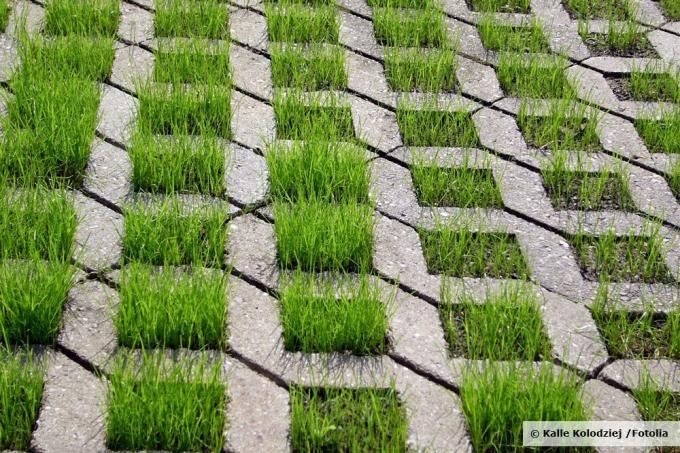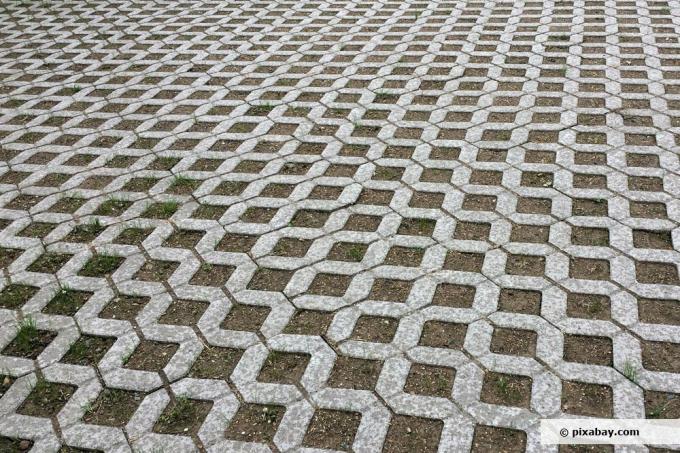
table of contents
- Grass pavers
- With or without substructure
- Step by step to the lawn grid: Instructions
- Without substructure
- 1. Prepare the area
- 2. Create subgrade
- 3. laying
- 4. Backfilling
- 5. Sowing
- With substructure
- 1. Excavation
- 2. Installation of stable materials
- 3. Create subgrade
- 4. laying
- 5. Backfilling
- 6. Sowing / environment
- Care and maintenance of the grass pavers
Ideally, we want to design our gardens, front gardens and other open spaces as green and natural as possible. But again and again this wish has to be reconciled with the requirements, the areas safe in all weathers and to be able to drive on permanently - be it as a parking space, as a driveway or as a set-up area for the fire brigade in the Fire. To the desire for race and to optimally combine the other requirements with one another, grass pavers offer a good and pragmatic solution. In the following, you will learn step by step how to properly lay the practical, yet near-natural flooring, both with and without a substructure.
Grass pavers
Before making a decision about how a lawn grating should be laid, the reasons that lead to its use must first be considered. If the goal of the installation is known and the foreseeable use is limited, this knowledge is right simply decide whether a substructure is required for the grass pavers or whether you can lay them without it permit.
Of course, there are many individual concerns that can lead to the use of the known grass pavers. However, numerous reasons arise again and again, so that they can be cited here as "standard" reasons, but without claiming to be exhaustive:
- Permeability of paved areas for rainwater is desired to reduce the wastewater fee
- Leakage capability required as the surface to be paved cannot be connected to the public sewer system
- Optical requirements, greening with lawn desired or The fastening of the surface should remain as invisible as possible
- Fastening with as little effort as possible, for example with only temporary access
- Other requirement of a permeable and at the same time resilient surface
With or without substructure
When which execution makes sense
Once the decision to lay the grass pavers has been made, the technical implementation of the project begins. First of all, there are two variants that differ in terms of their execution associated effort, but also fundamental in terms of their durability and resilience differentiate:
1. Lawn grid without substructure
- Installation situation: after the lawn has been removed, directly on the existing soil
- Resilience: strongly dependent on the existing subsurface, but clearly limited by insufficient frost protection
- Advantages: low installation effort, inexpensive, can be easily dismantled if necessary
- Disadvantages: low resilience, limited durability, high maintenance costs
2. Lawn grid with substructure
- Installation situation: on a gravel packing made of frost-proof and load-bearing materials
- Resilience: can be easily implemented for cars and trucks by taking suitable measures on the ground
- Advantages: high durability, high load capacity
- Disadvantages: high expenditure in construction, high acquisition costs, high expenditure in dismantling
Step by step to the lawn grid: Instructions
After the benefits and the different options for lawn pavers are known, the implementation begins. For both the variant without and the implementation with a substructure, the necessary work is explained step by step in the following instructions.
Without substructure
Laying the stones without first creating a load-bearing and frost-proof subsurface is quite simple:
1. Prepare the area
- remove existing surface
- Lawn can either be disposed of or stored on the side for the installation of sections in the grid stones
2. Create subgrade
- Level the soil with a rake, shovel or lath to lay the lawn grating evenly
- Align the upper edge of the prepared substrate with the height of the lattice stones
- After laying, stones should be flush with the top edge of the grass hub
tip: Since the creation of a subgrade directly on or can be difficult with the existing soil, it is worth applying a few bags of fine grit. The material can easily be installed by hand and drawn flat with a rake or a lath. In this way, the level surface succeeds perfectly without having to accept enormous additional costs. Depending on the size of the stones, 1 to 2 centimeters of the split is sufficient.
tip: In the case of particularly soft ground, it is worthwhile not to set the lawn grating flush with the upper edge of the lawn. Instead, the stones should be moved one to two centimeters upwards. When exposed to stress, these sink in and do not form any holes in the existing lawn.
3. laying
- Lay the grass pavers seamlessly on the prepared subgrade
- Knock stones loosely into the fine subgrade with a rubber mallet to avoid cavities and wobbly surfaces
tip: Since there is usually no exact edge for laying the stones after the turf has been cut out, it is worthwhile Erection of a batter board from branches, carpenter nails or other aids, over which a cord as a straight edge is tensioned.
4. Backfilling
- Filling the voids in and between the lattice stones with earth or a soil-gravel mixture for later lawn growth or gravel, if only seepage is required
- If the lawn growth is desired, it can be covered with turf turf cut off at the beginning

Attention: When filling, the materials in the individual compartments do not have to be compacted. However, cavities or incomplete filling should be avoided, as the fillings ultimately help to secure the position of the lattice stones. If necessary, the compartments should be opened after a few weeks or If the material used has settled, it can be refilled again during rainy periods.
5. Sowing
- If the greening is desired, sow the lawn by opening the compartments
- Regular watering required until germination
- when adding gravel, increased water requirement due to good drainage effect
Note: Even with the most careful installation of the grid surface, you must reckon with permanent deformation of the covering under load. When vehicles are driven on, for example, fairways are almost inevitable, so that here the alternative construction with a suitable underground improvement should be considered should.
With substructure
If a lawn grating is to be created permanently and resiliently, it is worth erecting it on a deep bed of gravel. This subsurface maintains its drainage capacity, but at the same time guarantees stability when exposed to loads from vehicles etc. Furthermore, the structure prevents the floor from lifting in frost, as the freezing moisture is drained away. This effectively prevents deformations on the pavement. The creation succeeds step by step as follows:
1. Excavation
- Top soil in the area of the planned area including the sod, as well as approx. 0.5 m beyond this, remove and dispose of
- Sward if necessary store on the side for later reuse
- Area min. Dig up 80 centimeters deep and dispose of the excavated material
Note: The minimum excavation depth should be 80 centimeters, as the soil normally no longer freezes at this depth and deformations are thus avoided. In the case of particularly poor soils with little load-bearing capacity, on the other hand, greater depths may be required, especially if a particularly high load-bearing capacity is desired. The assessment of these facts should definitely be carried out by competent persons, since the load-bearing capacity is difficult to determine without specialist knowledge.
2. Installation of stable materials
- Fill the pit with suitable load-bearing materials, e.g. gravel, pre-sieve, in the case of high stress, KFT (combined frost and base layer)
- Install materials in layers up to a maximum of 30 centimeters in height and compact with a vibrating plate or tamper after each layer
- Create the top edge according to the height of the lattice stones
3. Create subgrade
- Prepare detailed planning from fine gravel or sand on a load-bearing gravel package
- to do this, apply the split and distribute it with a rake
- then pull it off evenly and evenly using the lath
tip: For larger areas, it is worth borrowing a leveling laser in order to achieve as flat a surface as possible. Alternatively, wooden supports can be set up in the edge of the area using a spirit level, which can be used to pull off the stick.
4. laying
- Lay lattice stones on fine subgrade flush with no gaps
- Use a rubber mallet to knock the stones lightly into the fine subgrade to ensure a snug fit without cavities.
tip: A batter board made of sticks, metal rods or the like and stretchable cord helps to achieve a straight starting edge for laying.
5. Backfilling
- Fill the compartments of the lattice stones with earth, earth-gravel mixture or gravel
- Share of soil depending on the desired greening or simply ensuring that it can seep
- Completely fill the chambers in order to prevent the fillings from settling later
- in the case of gravel filling, fill this slightly above the upper edge of the stone and then shake it in with a vibrating plate
- Sweep off any remaining material
6. Sowing / environment
- If greening is desired, sow lawn seeds in grid compartments and water them well and keep them permanently moist, analogous to normal lawn seeds
- Fill the edge strips of the substructure around the grid area with previously removed excavation and re-lay the lawn sods on the side, press firmly and water well

Care and maintenance of the grass pavers
Once the lawn grating has been created and - if desired - greened, it can be used as a driveway, access or parking area without restriction. So that it stays that way in the long term, some aspects of care or Maintenance are taken into account:
Subsidence
Without a stable substructure, subsidence can occur over time, especially in the area of the lanes
Remedy:
- Regular removal of the stones and leveling of the subsurface
- optional change to the installation of a load-bearing layer in order to strengthen the subsurface
Dwindling recognizability
Over time it can happen that the greening covers the stones with biomass. In the long term, the lattice stones are no longer recognizable and the slippery humus layer makes them difficult to drive on.
Remedy:
- regular mowing and removal of the clippings
- Check for humus formation and, if necessary, push the humus cover over the stones
Tipping or splitting the stones
Due to an increased load in the edge area, as well as the movement of the stones among each other when driving on, the stones can tip over to the side or gaps and joints arise between the stones.
Remedy:
- Formation of a lawn grid in the edge area without direct access
- alternatively, discounts secured by lean concrete
- Remove the stones for joints and crevices and level the subsurface with subsequent re-laying





